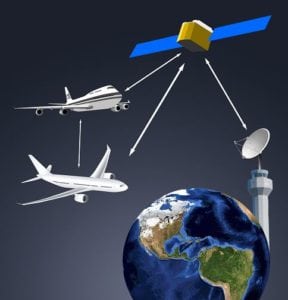Latest News
[Via Satellite 01-04-2017] Satellite-enabled aircraft tracking, known as Automatic Dependent Surveillance-Broadcast (ADS-B), can help to curb aviation carbon emissions in the near term, a new study by Purdue University confirms. Government bodies in Europe, the United States, Australia and other regions throughout the world currently require that most aircraft equip with ADS-B technology to reduce aircraft separation and help pilots fly more efficient routes. However, while aviation authorities have put terrestrial infrastructure in place to enable the technology, its impact is limited over remote and oceanic regions.
“Terrestrial ADS-B is impractical over much of the ocean, because it requires ground-stations. In shallow, near-shore waters it is possible to have such stations, but the logistics in the open ocean make terrestrial ADS-B are far too challenging,” report author Karen Marais told Via Satellite. “Currently satellite-based technologies like ADS-B are the most practical solution to providing navigation coverage over the open ocean.”
The Purdue University report, “Environmental Benefits of Space-based ADS-B,” released in late December, used fast-time simulations to model air traffic flow, comparing fuel burn to current and future routes. The findings of the study indicate that the implementation of satellite-based ADS-B specifically can offer benefits that will ultimately prevent approximately 14.3 million metric tons of carbon dioxide (CO2) from being released into the atmosphere between 2020 and 2030. It accomplishes this by using more precise locating capabilities and enabling optimum altitudes, speeds and routes.
According to the report, each year, U.S. passenger airlines crossing the North Atlantic burn approximately 2000 million gallons of fuel, according to information from the 2016 MIT Airline Data Project. “Adding up the benefits from the operational improvements discussed in this paper, airlines could, by 2020, save about 441 million kg of fuel annually, and by 2025, 480 million kg,” the report states. “In terms of carbon dioxide reductions, implementing space-based ADS-B offers potential benefits equivalent to taking approximately 292 822 cars off the road by 2020, or 318 718 cars by 2025.”
Inefficient oceanic and remote airspace routes are contributing to a significant amount of commercial aviation’s emissions, which are, in turn, contributing to about 2 percent of global manmade CO2 emissions annually, according to 2015 estimates from the International Civil Aviation Organization (ICAO). This is a result of the lack of radar coverage in remote regions, which currently operate under separate procedures as compared to radar-controlled airspace. Due to lack of real-time surveillance in oceanic and remote regions where terrestrial surveillance is currently a non-option, air traffic control separates aircraft procedurally by approximately 50 nautical miles.
“While 1 or 2 percent may not seem like much, it does add up to significant total emissions savings each year, as the study showed,” Marais told Via Satellite. “The big advantage of operational improvements is that they often require little or no improvements in aircraft technology and can be implemented much more quickly for an immediate benefit.”
Near term solutions to lower aviation carbon emissions are few and far between, according to Marais. The aviation industry is currently looking to tackle the issue in several ways, including designing and building more efficiently engines and airframes, and developing alternative sustainable fuels, but these are all longer-term solutions. By facilitating more efficient operations and flying better routes between point A and point B, which satellite-based ADS-B promises to provide, the industry can cut back on emissions as soon as satellites enabling this technology are operational.
The report cites a 2016 analysis from NAV CANADA pertaining to a major U.S. carrier indicating that, better routing, access to higher altitudes as fuel is burned and variable airspeed can result in an annual savings of approximately $18.25 million, or $475 per flight. More importantly, perhaps, the report finds that the technology can help the aviation industry fall in line with the Carbon Offset and Reduction Scheme for International Aviation (CORSIA) agreement, established by ICAO this past fall to reduce aviation emissions. It also supports the White House goal to reduce the United States emissions below 2005 levels, a reduction of 26 to 28 percent.
While Marais admits that the findings about reducing emissions were largely in line with her expectations, the report helps to close the business case for companies investing in space-based ADS-B such as Aireon, which requested the report as an impartial-objective analysis of the potential benefits. The company is poised to provide space-based ADS-B in 2018, shortly after the completion of the Iridium NEXT satellite constellation, which aims to provide global coverage via 66 operational Low Earth Orbit (LEO) satellites that will enable better navigation capabilities and also offer Air Navigation Service Providers (ANSPs) global aircraft surveillance capability.
But even with near-term change possible from these satellite-based operations, it will mean a large cultural shift for pilots before the industry can render full benefits from space-based tracking operations.
“The biggest challenge lies in changing the culture of how air traffic control and airlines use the airspace — for example, recent experimental trials in Hudson Bay found that even when pilots were given the option to request ascent to higher, more fuel-optimal altitudes, many did not ask for it — they were simply not used to the idea,” Marais said.
Get the latest Via Satellite news!
Subscribe Now